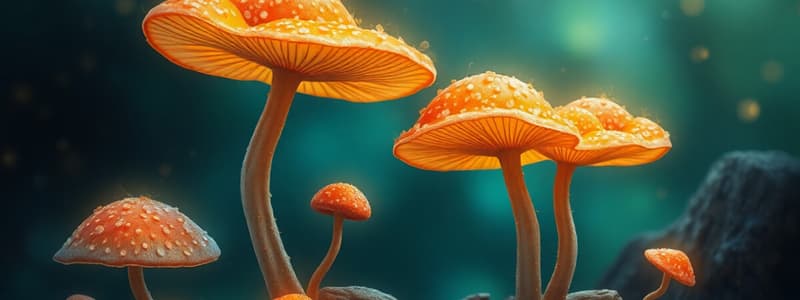Podcast
Questions and Answers
Apa yang dimaksudkan dengan lichen?
Apa yang dimaksudkan dengan lichen?
- Gabungan antara kulat dan alga atau cyanobacterium. (correct)
- Hanya sejenis kulat.
- Gabungan antara dua jenis serangga.
- Hanya sejenis alga.
Mengapa kulat dikategorikan sebagai penting dalam pengeluaran makanan?
Mengapa kulat dikategorikan sebagai penting dalam pengeluaran makanan?
- Kerana ia dapat membunuh bakteria berbahaya.
- Kerana ia dapat menjana elektrik.
- Kerana ia digunakan dalam penghasilan produk seperti keju, roti, dan sos soya. (correct)
- Kerana ia digunakan dalam penghasilan vaksin.
Apa kesan negatif yang boleh disebabkan oleh kulat kepada kesihatan manusia?
Apa kesan negatif yang boleh disebabkan oleh kulat kepada kesihatan manusia?
- Mengakibatkan jangkitan kulat (mycoses) yang merbahaya. (correct)
- Memberi punca kepada penghasilan makanan.
- Meningkatkan sistem imun.
- Menghasilkan antibiotik.
Bagaimana kulat boleh mempengaruhi kestabilan makanan?
Bagaimana kulat boleh mempengaruhi kestabilan makanan?
Apakah kesan ekonomi negatif yang boleh terjadi akibat kulat?
Apakah kesan ekonomi negatif yang boleh terjadi akibat kulat?
Apakah ciri-ciri yang membezakan fungi daripada tumbuhan dan haiwan?
Apakah ciri-ciri yang membezakan fungi daripada tumbuhan dan haiwan?
Bagaimana fungi mengangkut nutrien dari persekitaran mereka?
Bagaimana fungi mengangkut nutrien dari persekitaran mereka?
Apakah peranan fungi sebagai pengurai dalam ekosistem?
Apakah peranan fungi sebagai pengurai dalam ekosistem?
Secara keseluruhan, apakah jenis pembiakan yang fungi lakukan?
Secara keseluruhan, apakah jenis pembiakan yang fungi lakukan?
Apakah struktur khas yang dibentuk oleh fungi untuk menyerap nutrien dengan lebih efisien?
Apakah struktur khas yang dibentuk oleh fungi untuk menyerap nutrien dengan lebih efisien?
Bagaimana fungi menyumbang kepada pengeluaran ubat-ubatan?
Bagaimana fungi menyumbang kepada pengeluaran ubat-ubatan?
Apa itu mycorrhizae dan apa peranan mereka?
Apa itu mycorrhizae dan apa peranan mereka?
Apakah yang menjadi faktor utama kepada pelbagai peranan ekologi fungi?
Apakah yang menjadi faktor utama kepada pelbagai peranan ekologi fungi?
Flashcards
Lichens
Lichens
Symbiotic associations of fungi and algae/cyanobacteria.
Imperfect Fungi
Imperfect Fungi
Fungi grouped by asexual reproduction; their true group may be revealed later by phylogeny.
Fungi as Food
Fungi as Food
Many fungi are edible and used as food globally.
Fungal Industrial Uses
Fungal Industrial Uses
Signup and view all the flashcards
Fungi and Health
Fungi and Health
Signup and view all the flashcards
Fungi Nutrition
Fungi Nutrition
Signup and view all the flashcards
Fungal Reproduction
Fungal Reproduction
Signup and view all the flashcards
Fungal Cell Wall
Fungal Cell Wall
Signup and view all the flashcards
Fungal Ecology - Decomposers
Fungal Ecology - Decomposers
Signup and view all the flashcards
Fungal Morphology
Fungal Morphology
Signup and view all the flashcards
Fungal Symbiosis
Fungal Symbiosis
Signup and view all the flashcards
Fungal Yeasts
Fungal Yeasts
Signup and view all the flashcards
Mycelium
Mycelium
Signup and view all the flashcards
Study Notes
General Characteristics
- Fungi are a diverse group of eukaryotic organisms, distinct from plants, animals, and prokaryotes (bacteria and archaea).
- Characterized by a unique mode of nutrition: they are heterotrophic, absorbing organic matter from their surroundings rather than producing it.
- Typically reproduce sexually and asexually using spores.
- Cell walls are composed of chitin.
- Exhibit a wide range of morphologies, from single-celled yeasts to multicellular molds and mushrooms.
- Play crucial roles in ecosystems as decomposers, symbionts, and pathogens of plants and animals.
Nutrition and Metabolism
- Fungi absorb nutrients from their environment through external digestion.
- Enzymes are secreted to break down complex organic molecules into simpler compounds that can then be absorbed.
- Many fungi exhibit a specialized hyphal network (mycelium) for efficient nutrient uptake.
- Fungi are crucial in decomposition, breaking down dead organic matter.
- Different fungi have specific nutrient preferences, impacting their ecological roles.
Reproduction
- Fungi reproduce both sexually and asexually, often using spores as dispersal units.
- Asexual reproduction involves mitosis, producing genetically identical spores.
- Sexual reproduction involves meiosis, producing genetically diverse spores.
- Spore formation occurs in various structures, tailoring dispersal strategies.
- Specific mechanisms exist to promote genetic variability and environmental survival.
Ecological Roles
- Decomposers: play a critical role in nutrient cycling, breaking down dead organic matter.
- Symbionts: form close relationships with other organisms, both beneficial and detrimental. Mycorrhizae (a symbiotic relationship between fungi and plant roots) enhance nutrient uptake, while some fungi are pathogens to plants and even animals.
- Pathogens: cause diseases in various plants and animals. A wide range of fungal diseases are known to infect crops, forests, and human populations.
- Source of medicines: Some fungi produce valuable secondary metabolites with medicinal properties. Certain species of Penicillium, for instance, are crucial for the production of antibiotics.
Types of Fungi
- Yeasts (single-celled): reproduce asexually by budding.
- Molds (multicellular): typically have filamentous structures called hyphae.
- Mushrooms (multicellular): macroscopic fruiting bodies that develop from mycelium.
- Lichens (symbiotic combination): a unique association of a fungus and an alga/cyanobacterium.
- Imperfect fungi (Deuteromycetes): grouped based on asexual reproduction, sometimes transitioning to known groups based on phylogenetic analysis later.
Significance
- Food source: Many species are edible and used as food in various cultures. Examples include mushrooms like shiitake and portobello.
- Industrial applications: Fungi are used in food production (cheese, bread, soy sauce), fermentation processes, and the production of certain chemicals.
- Impact on human health (both positive and negative): Some fungi are essential for antibiotic production and other medicines. Conversely, certain fungal infections (mycoses) can be harmful and require medical treatment.
Economic Impact
- Food security: some fungal strains can enhance crop production.
- Economic losses: some types of fungi can cause significant damages to crops leading to economic loss.
- Industrial processes: used in numerous industrial processes, including those involving biofuel and bioproducts.
Studying That Suits You
Use AI to generate personalized quizzes and flashcards to suit your learning preferences.




